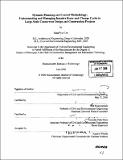| dc.contributor.advisor | Fred Moavenzadeh and Feniosky Peña-Mora. | en_US |
| dc.contributor.author | Lee, Sang Hyun, 1973- | en_US |
| dc.contributor.other | Massachusetts Institute of Technology. Dept. of Civil and Environmental Engineering. | en_US |
| dc.date.accessioned | 2008-01-10T17:24:18Z | |
| dc.date.available | 2008-01-10T17:24:18Z | |
| dc.date.copyright | 2006 | en_US |
| dc.date.issued | 2006 | en_US |
| dc.identifier.uri | http://dspace.mit.edu/handle/1721.1/34672 | en_US |
| dc.identifier.uri | http://hdl.handle.net/1721.1/34672 | |
| dc.description | Thesis (Ph. D.)--Massachusetts Institute of Technology, Dept. of Civil and Environmental Engineering, 2006. | en_US |
| dc.description | Vita. | en_US |
| dc.description | Includes bibliographical references (v. 1, leaves 174-180). | en_US |
| dc.description.abstract | Construction projects are uncertain and complex in nature. One of the major driving forces that may account for these characteristics is iterative cycles caused by errors and changes. Errors and changes worsen project performance and consequently, cause schedule and cost overruns to be prevalent. In particular, these iterative cycles are more detrimental when large-scale concurrent design and construction is applied. In an effort to address these issues, this research proposes Dynamic Planning and control Methodology (DPM) as a robust design and construction planning methodology for large-scale concurrent design and construction. The proposed DPM is composed of: 1) an error and change management framework that enables understanding of the construction processes associated with errors and changes and how they affect construction performance; 2) a proactive buffering strategy for reducing sensitivity to iterative error and changes cycles; 3) a System Dynamics-based construction project model which provides policy guidelines for the planning and control of projects; and | en_US |
| dc.description.abstract | (cont.) 4) a web-based error and change management system, which supports coordination of errors and changes among contractors and design professionals without hardware and software compatibility issues. Applying all research components into a couple of real world case projects, this research concludes that a concurrently developed project can benefit by: 1) adding realism to planning taking into account iterative error and change cycles; 2) implementing a proactive mechanism to look and act ahead against uncertainties; 3) making appropriate policies with the help of the system dynamics-based simulation model; and 4) facilitating coordination from the IT-supported management system; even if the time frame of a project is shortened. Also, future research opportunities are discussed extending the findings from this research. | en_US |
| dc.description.statementofresponsibility | by SangHyun Lee. | en_US |
| dc.format.extent | 2 v. (417 leaves) | en_US |
| dc.language.iso | eng | en_US |
| dc.publisher | Massachusetts Institute of Technology | en_US |
| dc.rights | M.I.T. theses are protected by copyright. They may be viewed from this source for any purpose, but reproduction or distribution in any format is prohibited without written permission. See provided URL for inquiries about permission. | en_US |
| dc.rights.uri | http://dspace.mit.edu/handle/1721.1/34672 | en_US |
| dc.rights.uri | http://dspace.mit.edu/handle/1721.1/7582 | |
| dc.subject | Civil and Environmental Engineering. | en_US |
| dc.title | Dynamic Planning and control Methodology : understanding and managing iterative error and change cycles in large-scale concurrent design and construction projects | en_US |
| dc.title.alternative | Understanding and managing iterative error and change cycles in large-scale concurrent design and construction projects | en_US |
| dc.type | Thesis | en_US |
| dc.description.degree | Ph.D. | en_US |
| dc.contributor.department | Massachusetts Institute of Technology. Department of Civil and Environmental Engineering | |
| dc.identifier.oclc | 71304485 | en_US |
